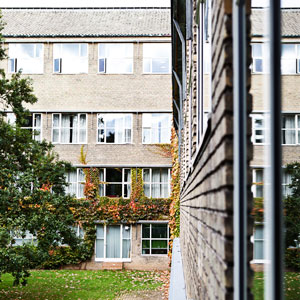PCBs will be removed from AU’s buildings
A report shows a moderately increased level of PCBs in ten buildings at ST and Aarhus BSS. Specific action plans have been initiated to remove PCBs from the buildings.

During the coming year, Aarhus University will remove possible sources of PCB contamination, such as old window joint sealant or lighting fixtures with damaged condensers. PCBs are hazardous chemicals that were used in a variety of building materials in the past. In relation to the levels of PCBs that have been detected, AU is following the Danish Health and Medicines Authority’s recommendation to reduce PCB levels within a period of one to two years.
An extensive investigation has been carried out and PCB levels have been measured in more than 300 buildings at AU owned by the Danish Building and Property Agency. The Danish Building and Property Agency’s report of 19 March 2015 contained the final results. Increased levels have been found in indoor air in a total of ten buildings at ST and Aarhus BSS and the occupational health and safety organisations at these faculties have initiated specific actions plans to remove the PCBs from the buildings.
The measured PCB levels are at a moderately increased level, but in one room, critical PCB levels were measured. The affected buildings are:
- Building 1520 and 1522, Ny Munkegade 120 (ST)
- Building 1540, Ny Munkegade 114 (ST)
- Building 2620 and 2627, Fuglesangs Alle 4 (Aarhus BSS)
- Building 1323, 1325, 1327, 1328 and 1343, Bartholins Alle 10-16 (Aarhus BSS)
The one room where the critical level was measured is a room in the basement in building 1522 which has been empty for some time. The Danish Building and Property Agency informed the university about the preliminary results in advance in September, so the work could be initiated to remove the source of the critical PCB levels and the room could be cleaned. A condenser in a lighting fixture was leaking and this had caused the critical levels of PCB.
All buildings will be checked
Charlotte Lyngholm, Head of Estates Projects and Development, explains: ”We wish to remove all elements of uncertainty concerning PCBs and get a complete overview of possible PCBs in AU’s buildings. Measuring PCB levels in external tenancies will be completed by the end of April 2015.
PCBs were used until 1977 (in lighting fixtures until 1986) and the majority of the remaining 200 buildings were built after this period, so it is not relevant to measure the PCB levels in these cases.
Action plans
PCBs are health hazards and must be removed from the ten AU buildings where the levels exceed the Danish Health and Medicines Authority’s permissible exposure limit of 300 ng pcb/m3 air in cases of daily exposure for eight hours or more.
When the PCB level is between 300 and 3000 ng, the Danish Health and Medicines Authority recommends that initiatives be taken to bring the PCB levels down within a period of 1 to 2 years. If the level is critical - above 3000 - it is recommended that corrective measures be taken immediately.
After being informed of the preliminary results of the investigation, the occupational health and safety committees at the affected faculties started to prepare and implement detailed action plans in cooperation with Estates Facilities. This means that work is being done to identify and remove possible sources of PCBs and carry out expert cleaning of the rooms affected. At ST and at Aarhus BSS, this work is expected to be completed during 2015.
The action plans for the affected buildings will be available on the faculties’ staff portals as soon as they are ready, and PCB levels will be measured again subsequently to check the levels.
Members of staff who work in the affected buildings will be contacted directly and receive separate information about what measures they should take.
The faculties will inform about the specific PCB measurements and their consequences, including any temporary closure of rooms in connection with renovation work.
Facts about PCBs
‘PCBs’ is an abbreviation for polychlorinated biphenyls, which are hazardous synthetic chemical compounds. In Denmark, PCBs were used in the production of a range of building materials such as joint sealant, paint, adhesive in double-glazed windows and flooring in the period from 1950 to 1977. Humans can absorb PCBs by touch, inhalation or through food; the latter is typically the primary source. PCBs are not suspected of causing acute illness, but prolonged exposure over a number of years can lead to a variety of adverse health effects. In case of pregnancy, it is important to be particularly cautious as PCBs can be passed on to the foetus.
Read more about PCBs here http://pcb-guiden.dk/ (in Danish)
Further information
- Read the Danish Building and Property Agency’s entire PCB report about Aarhus University here (in Danish)
- Find the answers to the most frequently asked questions here.
